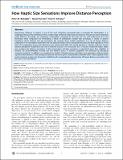| dc.contributor.author | Battaglia, Peter W. | |
| dc.contributor.author | Kersten, Daniel | |
| dc.contributor.author | Schrater, Paul R. | |
| dc.date.accessioned | 2011-10-03T15:31:37Z | |
| dc.date.available | 2011-10-03T15:31:37Z | |
| dc.date.issued | 2011-06 | |
| dc.date.submitted | 2010-12 | |
| dc.identifier.issn | 1553-7358 | |
| dc.identifier.issn | 1553-734X | |
| dc.identifier.uri | http://hdl.handle.net/1721.1/66155 | |
| dc.description.abstract | Determining distances to objects is one of the most ubiquitous perceptual tasks in everyday life. Nevertheless, it is challenging because the information from a single image confounds object size and distance. Though our brains frequently judge distances accurately, the underlying computations employed by the brain are not well understood. Our work illuminates these computions by formulating a family of probabilistic models that encompass a variety of distinct hypotheses about distance and size perception. We compare these models' predictions to a set of human distance judgments in an interception experiment and use Bayesian analysis tools to quantitatively select the best hypothesis on the basis of its explanatory power and robustness over experimental data. The central question is: whether, and how, human distance perception incorporates size cues to improve accuracy. Our conclusions are: 1) humans incorporate haptic object size sensations for distance perception, 2) the incorporation of haptic sensations is suboptimal given their reliability, 3) humans use environmentally accurate size and distance priors, 4) distance judgments are produced by perceptual “posterior sampling”. In addition, we compared our model's estimated sensory and motor noise parameters with previously reported measurements in the perceptual literature and found good correspondence between them. Taken together, these results represent a major step forward in establishing the computational underpinnings of human distance perception and the role of size information. | en_US |
| dc.description.sponsorship | National Institutes of Health (U.S.) (NIH grant R01EY015261) | en_US |
| dc.description.sponsorship | University of Minnesota (UMN Graduate School Fellowship) | en_US |
| dc.description.sponsorship | National Science Foundation (U.S.) (Graduate Research Fellowship) | en_US |
| dc.description.sponsorship | University of Minnesota (UMN Doctoral Dissertation Fellowship) | en_US |
| dc.description.sponsorship | National Institutes of Health (U.S.) (NIH NRSA grant F32EY019228-02) | en_US |
| dc.description.sponsorship | Ruth L. Kirschstein National Research Service Award | en_US |
| dc.language.iso | en_US | |
| dc.publisher | Public Library of Science | en_US |
| dc.relation.isversionof | http://dx.doi.org/10.1371/journal.pcbi.1002080 | en_US |
| dc.rights | Creative Commons Attribution | en_US |
| dc.rights.uri | http://creativecommons.org/licenses/by/2.5/ | en_US |
| dc.source | PLoS | en_US |
| dc.title | How Haptic Size Sensations Improve Distance Perception | en_US |
| dc.type | Article | en_US |
| dc.identifier.citation | Battaglia, Peter W., Daniel Kersten, and Paul R. Schrater. “How Haptic Size Sensations Improve Distance Perception.” Ed. Konrad P. Körding. PLoS Computational Biology 7 (2011): e1002080. | en_US |
| dc.contributor.department | Massachusetts Institute of Technology. Computer Science and Artificial Intelligence Laboratory | en_US |
| dc.contributor.department | Massachusetts Institute of Technology. Department of Brain and Cognitive Sciences | en_US |
| dc.contributor.approver | Battaglia, Peter W. | |
| dc.contributor.mitauthor | Battaglia, Peter W. | |
| dc.relation.journal | PLoS Computational Biology | en_US |
| dc.eprint.version | Final published version | en_US |
| dc.type.uri | http://purl.org/eprint/type/JournalArticle | en_US |
| eprint.status | http://purl.org/eprint/status/PeerReviewed | en_US |
| dspace.orderedauthors | Battaglia, Peter W.; Kersten, Daniel; Schrater, Paul R. | en |
| dc.identifier.orcid | https://orcid.org/0000-0002-9931-3685 | |
| mit.license | PUBLISHER_CC | en_US |
| mit.metadata.status | Complete | |
